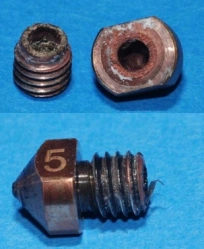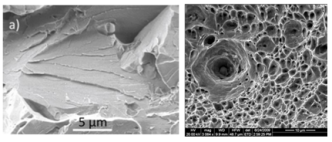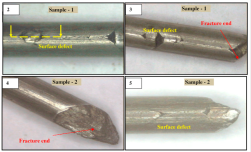![]() Quatre Cas Concrets d’analyse de défaillance sous forme de fiches traitant de ruptures par fissuration progressive et de ruptures brutale semi-fragiles à retrouver dans la Mécatech du Cetim.
Quatre Cas Concrets d’analyse de défaillance sous forme de fiches traitant de ruptures par fissuration progressive et de ruptures brutale semi-fragiles à retrouver dans la Mécatech du Cetim.
Archives du mot-clef rupture fragile
Cas concrets – Ruptures de pièces de manutention-levage
![]() Une série de quatre fiches d’analyses de défaillances de pièces mécaniques sont consultables en ligne dans la Mécatech. Elles concernent des pièces de manutention-levage.
Une série de quatre fiches d’analyses de défaillances de pièces mécaniques sont consultables en ligne dans la Mécatech. Elles concernent des pièces de manutention-levage.
Retrouvez dans la Mécatech les ré-éditions des fiches d’analyse de cas concrets que le Cetim a publié dans la revue Cetim-Informations dans les années 1974 à 1990. Bien qu’anciennes, le contenu de ces fiches est toujours d’actualité.
Weld failure analysis of 2205 duplex stainless steel nozzle
 A publication in « Case Studies in Engineering Failure Analysiss, october 2014.
A publication in « Case Studies in Engineering Failure Analysiss, october 2014.
Failure analyses of weld joint between the nozzle and the head of the reactor made of 2205 duplex stainless steel was performed by optical microscopy (OM) and scanning electron microscopy (SEM). Cracks were found in HAZ of the weld. The depth of the cracks is equal to the thickness of the inner weld. Localized uneven distribution of ferrite/austenite with 80-90% ferrite in weld is found. Results show that the cracks occurred along columnar granular with cleavage fracture. Poor weld process probably results in these cracks.
Vintage-La rupture en service des assemblages vissés
 Les experts en analyse de défaillances du Cetim ont réalisé courant 1988 une étude statistique de 139 cas de ruptures d’assemblages vissés. Les résultats ont montré que pour les deux tiers des cas traités, 53 % des cas de rupture est dû à un phénomène de fissuration progressive et 47 % correspond à des ruptures brutales. Pour le tiers restant, plusieurs causes conjuguées étaient à l’origine des défaillances.
Les experts en analyse de défaillances du Cetim ont réalisé courant 1988 une étude statistique de 139 cas de ruptures d’assemblages vissés. Les résultats ont montré que pour les deux tiers des cas traités, 53 % des cas de rupture est dû à un phénomène de fissuration progressive et 47 % correspond à des ruptures brutales. Pour le tiers restant, plusieurs causes conjuguées étaient à l’origine des défaillances.
Failure analysis of 4Cr13 stainless steel linkages in circuit breakers
 A case study published in « Case Studies in Engineering Failure Analysis » – April 2016.
A case study published in « Case Studies in Engineering Failure Analysis » – April 2016.
In this study, the fracture failure of the 4Cr13 stainless steel linkage components in circuit breakers was studied. The microstructure and morphology of fracture surface were observed by scanning electron microscopy and optical microscopy. A micro-Vickers tester measured the hardness of the components. The tensile strength and strain of the components were determined by a universal testing machine. The results show that fracture failure mode was quasi-cleavage fracture, and some dimples and edges of cleavage were present on the fracture surface.
Effect of Hydrogen Charging on the Wear Behavior of Spring Steel
 An article published in the « International Journal of Engineering Science and Computing« , June 2016.
An article published in the « International Journal of Engineering Science and Computing« , June 2016.
Spring steel is a prominent piece of material in industrial and automotive application. Hydrogen embrittlement (HE) is an inherent phenomenon, which will occur during the course of service life, at the same time it has to sustain a variety of loads acting on it. Among all the wear of spring steel plays a vital role. Hydrogen embrittlement leads for pre mature failure of the component. In view of this, an attempt was made in this experimental study to performance of hydrogen embrittled spring steel (EN-47 / SAE 6150/SUS 10) under the dry sliding condition. The specimen preparation and the experimentations have been carried out according to the ASTM standards. The experiments performed based on plan of taguchi technique. Cathodic charging is having been adopted for the embrittlement of the spring steel material. A known level of embrittlement has made, wear test has been carried out. Results have shown that, load and sliding distance is more pronounced on the wear of the embrittled spring steel material rather than speed.
Fragilisation par hydrogène d’un cupro-béryllium
 Nous rapportons ici un article de Engineering Systems, Inc., (ESI) au USA, publié sur www.esi-website.com. L’article concerne l’analyse des causes de rupture intergranulaire de buses en cupro-béryllium C17200 équipant une imprimante 3D. Les buses se sont rompues en service à haute température (210-300°C).
Nous rapportons ici un article de Engineering Systems, Inc., (ESI) au USA, publié sur www.esi-website.com. L’article concerne l’analyse des causes de rupture intergranulaire de buses en cupro-béryllium C17200 équipant une imprimante 3D. Les buses se sont rompues en service à haute température (210-300°C).
Les résultats des analyses réalisées amènent à la conclusion qu’il s’agit d’un phénomène de rupture intergranulaire due à une fragilisation par hydrogène sur un alliage de cuivre riche en oxygène.
Ce type de fragilisation n’est pas courant, n’hésitez pas à contacter les experts défaillances du Cetim et ses partenaires.
Failure of Metals I – Brittle and Ductile Fracture
 A ne pas manquer de lire sur researchgate.net, trois publications intégrales et récentes sur « La ruptures des métaux » rédigées par André Pineau, A.A. Benzerga et Thomas Pardoen.
A ne pas manquer de lire sur researchgate.net, trois publications intégrales et récentes sur « La ruptures des métaux » rédigées par André Pineau, A.A. Benzerga et Thomas Pardoen.
La première concerne la rupture ductile et fragile. Il s’agit d’une vue d’ensemble des phénomènes de ruptures sous chargement monotone dans un contexte d’approche globale.
« This is the first of three overviews on failure of metalsHere, brittle and ductile failure under monotonic loadings are addressed within the context of the local approach to fracture.In this approach, focus is on linking microstructure, physical mechanisms and overall fracture properties….. »
Wire breakage of Tyre bead grade
 A new case study in « Case Studies in Engineering Failure Analysis » of October 2015.
A new case study in « Case Studies in Engineering Failure Analysis » of October 2015.
Tyre bead grade wire is used for tyre making application. The wire is used as reinforcement inside the polymer of tyre. The wire is available in different size/section such as 1.6 mm to 0.80 mm thin Cu coated wire. During tyre making operation at tyre Manufacturer Company, wire failed frequently. In this present study, different broken/defective wire samples were collected from Wire Mill for details investigation of the defect. The analysis revealed that, white layer of surface martensite was formed and it was caused the final breakage of wire. In this study they have also discussed about the possible reason for the formation of such kind of surface martensite (hard-phase).
Failure analysis of the pulleys during the press-fit assembling process

A new case studie in engineering failure analysis published on SienceDirect.com. The present article highlights failure investigation of the pulleys during a press-fit assembling process. Pulleys are used to transmit power between rotational mechanical elements. It was found that cooperative influence of higher carbon content with combination of elongated sulphides is reason for pulleys cracking. Steel cleanliness and homogeneous structure is an important factor for users of steel. The success of production process is connected with the optimal quality of steel.

